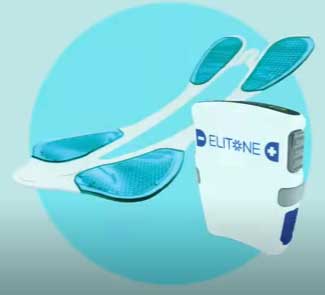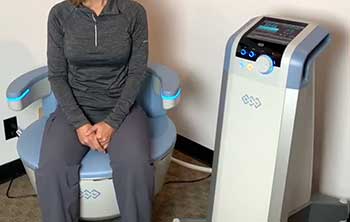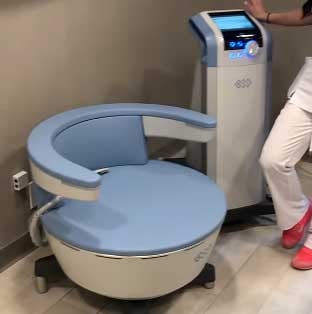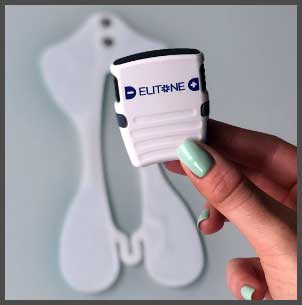Pelvic floor dysfunction affects nearly one quarter of all women in the United States. Symptoms include urinary incontinence, fecal incontinence, pelvic organ prolapse, and sexual dysfunction. Pelvic floor muscle weakness is frequently the culprit.
Kegel exercises provide a low-cost treatment option, but compliance is often poor. Hence, interest is growing in pelvic floor electrical stimulators that automate the training process.
EMSELLA and ELITONE are two of the most popular options on the market today. Both devices use electromagnetic energy to induce pelvic floor muscle contractions. Treatment sessions last 28 minutes and do not require disrobing.
Patients sit fully clothed while the stimulator delivers thousands of Kegel-like contractions over the span of each session. But there are some key differences between the two devices.
A Brief Comparison Table
| Feature | ELITONE | EMSELLA |
| FDA Clearance | No | Yes, for urinary incontinence |
| Technology | Low-frequency electromagnetic stimulation, 50 Hz | High-intensity focused electromagnetic (HIFEM®) |
| # of contractions per session | 11,200 | 12,000 |
| Muscle groups targeted | Levator ani, obturator internus | Full thickness of pelvic floor |
| Contraction intensity | Surface muscles only | Supramaximal, “turbo Kegels” |
| Body position | Upright sitting | 45° recline |
| Internal components | None, external only | None, but penetrates deeply |
| Evidence basis | Small pilot studies | FDA review + 2 published studies |
| Cost per session | $70-100 | $70-100 |
| Total cost | $700-1000 for 10 sessions | $700-1000 for 10 sessions |
| Side effects | Mild: muscle soreness, hot flashes, headaches | Mild: muscle soreness, hot flashes, headaches |
Comparing ELITONE and EMSELLA Pelvic Floor Stimulators

ELITONE operates at a frequency of 50 Hz and uses a saddle seat to deliver stimulation.
Patients sit upright with the pelvis supported.
The ELITONE stimulates the levator ani and obturator internus muscles.
Treatment is completely external with no internal probes.
Each session delivers 11,200 contractions.
EMSELLA, on the other hand, reclines patients at a 45-degree angle. It utilizes a different mechanism, HIFEM (High-Intensity Focused Electromagnetic) technology, to target the pelvic floor musculature. Stimulation penetrates deeper to activate muscles and connective tissue.
Treatment delivers 12,000 supramaximal contractions per session, which are interspersed with periods of rest. EMSELLA has FDA clearance for urinary incontinence while ELITONE does not.
As the comparison table shows, there are pros and cons to each device. Keep reading to learn more about how ELITONE and EMSELLA work, their effectiveness, costs, and considerations for determining which is the right choice.
How Pelvic Floor Stimulators Work?
Both ELITONE and EMSELLA utilize electromagnetic energy to cause repeated contractions of the pelvic floor muscles. This activates muscle fibers and nerves to improve strength, tone, and neuromuscular function. The stimulus contracts and relaxes the muscles rapidly, essentially working them out.
Regular pelvic floor muscle training can:
- Increase muscle mass
- Improve contractile force
- Heighten muscle reflexes and coordination
- Promote nerve regeneration
This leads to improved support for the urethra, bladder, uterus, and rectum. With stronger pelvic floor muscles, symptoms like incontinence and pelvic organ prolapse often diminish or resolve completely. Sexual function may also be enhanced.
Let’s take a closer look at how each device achieves these results:
- ELITONE
ELITONE uses electromagnetic stimulation at a low frequency of 50 Hz. Patients sit upright on a saddle-style seat. No internal probes are required. The ELITONE stimulates the levator ani and obturator internus muscles of the pelvic floor via the large saddle electrode situated under the buttocks.
Stimulation causes involuntary contractions of the pelvic floor that mimic Kegel exercises. Each 28-minute session delivers 11,200 muscle contractions. Treatments are typically administered twice per week for 5 weeks (10 total sessions). Maintenance sessions may be recommended thereafter.
- EMSELLA

EMSELLA utilizes HIFEM® technology, which stands for High-Intensity Focused Electromagnetic.
This allows the energy to penetrate deeper than ELITONE to target the full thickness of the pelvic floor musculature.
Patients recline at a 45-degree angle in a chair similar to a dental exam chair.
The energy is delivered via a circular coil housed in the seat.
EMSELLA induces supramaximal (very strong) contractions that are interspersed with rest periods. A single session provides 12,000 contractions.
The recommended protocol is the same as ELITONE – 28-minute treatments twice per week for 5 weeks followed by maintenance. However, EMSELLA has FDA clearance for the indication of urinary incontinence, which ELITONE lacks.
Now let’s compare these two stimulators in terms of effectiveness, cost, comfort, pros, and cons.
ELITONE Vs. EMSELLA: Effectiveness
Clinical studies support both ELITONE and EMSELLA as effective non-invasive treatments for improving pelvic floor dysfunction, especially urinary incontinence. However, there are some differences in the strength of evidence.
ELITONE
A 2013 clinical trial of ELITONE found significant improvement in stress urinary incontinence (SUI) symptoms after 10 treatments over 5 weeks. Patients completed quality of life questionnaires and 3-day bladder diaries before and after. Results showed:
- 77% improvement in urinary leakage
- 87% improvement in quality of life
- Significant increases in pelvic floor muscle strength
These benefits were largely sustained at 6 months follow up. Another study investigated use of ELITONE for pelvic organ prolapse and sexual dysfunction. After 10 sessions, patients experienced less prolapse and improvement in desire, arousal, orgasm, and satisfaction.
So research confirms ELITONE strengthens pelvic floor muscles and improves bothersome symptoms. However, the studies are small and ELITONE does not yet have FDA clearance for urinary incontinence or other indications. Larger trials are still needed.
EMSELLA
EMSELLA has more robust clinical evidence. Two prospective studies of postpartum women with SUI evaluated a 14-session protocol (2x/week for 7 weeks). The findings:
- Study 1: Mean leakage reduced by 62% and 74% of women reached over 50% improvement (Alinsod 2018)
- Study 2: Mean leakage reduced by 49% and 50% of women achieved over 50% improvement (Borello-France 2019)
In 2018, the FDA granted Breakthrough Status to BTL, the manufacturer of EMSELLA, based on preliminary findings from these trials. The following year, EMSELLA received FDA 510(k) clearance for improvement of urinary incontinence in women.
The FDA reviewed data from over 1300 patients showing EMSELLA significantly improved leaks and quality of life. Supporting evidence was considered substantially equivalent to other FDA-cleared electrical stimulators.
So in terms of strength of evidence, EMSELLA appears to have the edge over ELITONE at this time. However, both devices demonstrate meaningful improvements for women with pelvic floor dysfunction after a series of treatments.
Cost Comparison: ELITONE Vs. EMSELLA
EMSELLA and ELITONE are close in price – about $3,500 to $4,000 for a complete series of treatments. Exact costs vary by provider.
Both treatments are considered elective and not covered by insurance. Some providers offer financing plans to offset the out-of-pocket expense. Packages are frequently priced as follows:
- $70 – $100 per session
- $700 – $1000 for a package of 10 treatments
- $250 – $500 for maintenance sessions
Despite lacking FDA clearance for incontinence, ELITONE is not significantly cheaper than EMSELLA. The costs are comparable. Total expenditures can range from around $2,000 to $4,000 depending on the clinic.
When weighing expense, it is important to consider potential cost savings from reducing or resolving symptoms. Fewer leaks means less spent on incontinence pads and laundry.
Improved pelvic support may obviate the need for pessaries or surgery. For suitable candidates, pelvic floor stimulators can be a cost-effective solution.
Also Read: Differences Between LegXercise PRO And MAX Leg Exercisers.
ELITONE Vs. EMSELLA: Comfort and Side Effects
Both ELITONE and EMSELLA are very well tolerated with minimal discomfort. The treatments do not hurt, though patients describe the pelvic contractions as unusual and surprising at first. There is no downtime or recovery following sessions.
The only notable side effect is occasional muscle soreness, similar to post-workout muscle fatigue. This resolves in 1 to 2 days. Other possible but uncommon effects include:
- Hot flashes
- Leg cramps
- Headaches
These mild side effects typically do not require intervention. There are no serious adverse events associated with either device. Both ELITONE and EMSELLA are considered very safe non-invasive treatments.
EMSELLA allows patients to recline, while ELITONE requires sitting upright on a saddle seat. Some patients find EMSELLA more comfortable and prefer the chair recline position.
However, neither device insertion or probes, so both stimulators are well-tolerated overall. Some additional differences in patient experience:

- EMSELLA reclines patients at a 45-degree angle in a chair. This is more comfortable for some.
- ELITONE requires sitting upright on a saddle seat. Patients need to be able to sit for 28 minutes.
- ELITONE lacks any internal components. Stimulation is delivered externally through the saddle seat.
- EMSELLA also does not require insertion of probes. However, its electromagnetic energy penetrates internally to stimulate the pelvic floor musculature.
- EMSELLA causes very strong muscle contractions, described as supramaximal or “turbocharged Kegels.” The intensity is greater than ELITONE.
- ELITONE stimulates surface pelvic floor muscles only. The contractions may feel less intense for some patients.
So in summary, EMSELLA allows a reclined position and might offer more intense muscle contractions. But both devices are comfortable, non-invasive, and overall very well tolerated.
Pros and Cons of ELITONE and EMSELLA Pelvic Floor Stimulators
Below is a summary of the main advantages and disadvantages of each pelvic floor stimulator:
ELITONE Pros:
- Non-invasive, no probes
- Well-tolerated with minimal side effects
- Stretngthens pelvic floor muscles
- Improves incontinence, prolapse, and sexual function
- Supports and enhances Kegel exercise
- No downtime or recovery needed
ELITONE Cons:
- Not FDA-cleared for urinary incontinence
- Less evidence overall compared to EMSELLA
- Must be able to sit on saddle seat for 28 minutes
- Less intense stimulation reaching only surface muscles
EMSELLA Pros:
- Clearance by the FDA for urinary incontinence
- More robust clinical evidence showing efficacy
- Reclined position for comfort
- Supramaximal contractions reaching deep muscles
- Also no downtime or recovery needed
EMSELLA Cons:
- Higher cost (though comparable to ELITONE)
- No clearance for indications beyond urinary incontinence
- Stimulation could potentially feel too intense for some
Also Read: Differences Between ELITONE And INNOVO Pelvic Floor Exercisers.
Who Are The Best Candidates?
As non-surgical options, both ELITONE and EMSELLA are best suited to women with mild to moderate pelvic floor dysfunction. This includes:
- Stress urinary incontinence
- Overactive bladder
- Fecal incontinence
- Pelvic organ prolapse
- Sexual dysfunction
The devices strengthen and retrain weak pelvic floor muscles. Women with severe prolapse or incontinence are better candidates for surgery.
However, pelvic floor stimulation may improve symptoms and forestall or avoid the need for surgery in some instances. These devices are ideal for women hoping to enhance pelvic floor strength and tone.
Other factors that make a patient a good candidate:
- Failed conservative therapies like Kegels
- Able to sit for 28 minutes comfortably
- No implanted devices like pacemakers
- No frequent UTIs or unresolved bladder infections
EMSELLA or ELITONE should not be used in place of electrical stimulation prescribed by a pelvic floor therapist. But they may be used together for an amplified strengthening effect.
Main Takeaways: ELITONE and EMSELLA for Pelvic Floor Dysfunction

- Both devices utilize electromagnetic stimulation to repeatedly contract and relax the pelvic floor muscles.
- This automated “Kegelcise” strengthens muscles and nerves to improve urinary and fecal incontinence.
- EMSELLA is FDA-cleared for urinary incontinence and has more robust clinical evidence.
- ELITONE also shows positive results but currently lacks FDA clearance.
- Effectiveness is proven for both, but EMSELLA may stimulate deeper musculature.
- The procedures are very well tolerated with minimal discomfort or side effects.
- Cost is comparable, around $3,500 – $4,000 for a complete treatment series.
EMSELLA and ELITONE provide two high-tech options for non-invasive pelvic floor rehabilitation. Consult with a provider to determine which device may be best suited for your needs and goals.
Dramatic improvement in incontinence and other pelvic floor disorders is possible without surgery using these innovative treatments.
Also Read: Is Elvie Better Than kGoal Pelvic Floor Trainer?
FAQs about Pelvic Floor Stimulators
Based on clinical evidence and FDA clearance, EMSELLA is considered the most proven and effective stimulator specifically for urinary incontinence. However, ELITONE is also an excellent option with emerging positive research results.
ELITONE is the main alternative to EMSELLA. Other options include intravaginal electrical stimulation devices or TENS units prescribed by pelvic floor physical therapists. Vaginal cones and regular Kegel exercises can also strengthen pelvic muscles without a device.
The main downsides to EMSELLA are the high out-of-pocket cost since it’s not covered by insurance, and the possibility that some patients may find the stimulation too intense. There are very few risks given its non-invasive nature.
Clinical studies show Elitone improves incontinence in 75-80% of women after 10 sessions. About 50-60% of patients see over 50% reduction in leakage. Some data indicate sustained benefits at 6 months. More research is needed, but current evidence indicates good effectiveness.
Wrapping Up
Both ELITONE and EMSELLA are innovative, non-surgical options for strengthening weak pelvic floor muscles. Clinical research shows 10 treatments with either device can significantly improve urinary incontinence, overactive bladder, fecal incontinence, pelvic organ prolapse, and sexual dysfunction.
EMSELLA has more robust evidence and FDA clearance specifically for urinary incontinence. However, ELITONE is also an effective treatment based on initial study results.
Women with mild to moderate pelvic floor dysfunction may benefit from these cutting-edge technologies that automate pelvic floor rehabilitation.

Does this work for men?